EDITOR’S NOTE: One more week before Devon Baxter returns to his regular Wednesday postings here – so I thought I’d use the open slot today to post a few reviews of material I received and enjoyed over the last few months. Consider these my Christmas suggestions – a gift guide for the cartoon nut in your life, or things to be added to your own personal Santa’s Wish List. – Jerry Beck
How To Read Nancy: The Elements of Comics in Three Easy Panels By Paul Karasik and Mark Newgarden (Fantagraphics).
 Let’s a get few things out of the way first. This is easily one of the most brilliant books about comics, a comics character, that character’s history – and the aesthetics of comics on the whole – ever written. And that’s saying something because there are many good books about those subjects – including the central subject herself.
Let’s a get few things out of the way first. This is easily one of the most brilliant books about comics, a comics character, that character’s history – and the aesthetics of comics on the whole – ever written. And that’s saying something because there are many good books about those subjects – including the central subject herself.
When I was a kid, the Nancy comic strip was always good for quick laugh – and nothing more was thought of it. By the late 60s, early 70s Nancy was considered (among the Marvel zombies, my underground comix reading pals and other aspiring cartoonists I was hanging out with) the squarest of the square. As the author’s note, even execs at its syndicator called it “The comic strip everyone loved to hate”. There were rumors that Bushmiller didn’t even draw it anymore – that he had 60 rubber stamps of Nancy and Sluggo in various poses which were used to quickly produce the daily panels. It was an early 1980s evening spent in the company of alternative cartoonist Jerry Moriatry (“Jack Survives”) that changed my mind – as he began to explain to me his POV on Bushmiller and Nancy, raising my consciousness and forcing me to reevaluate the strip.
I soon realized I wasn’t alone. Appreciating Nancy, studying its gags and structure, was what any serious student of comic art did. Eventually well-curated reprint books of Ernie Bushmiller’s greatest strips began appearing from publishers of the likes of Kitchen Sink and Fantagraphics. The first of these, Brian Walker’s The Best of Ernie Bushmiller’s Nancy (Henry Holt, 1988), contained Mark Newgarden and Paul Karasik’s original essay on “How To Read Nancy” – and that article has been expanded upon to create this masterpiece of a book.
On the one hand, this is an analysis of a single strip, broken down into 44 steps that dissect why Nancy works as pure comics. On the other hand, the book is the history of Ernie Bushmiller, his art, his comic strips and his philosophy (“The gag is the thing”). On the third hand, it’s a collection of some of best of Nancy (over 160 strips are reprinted throughout and especially in its last 40 pages). The book is bursting with rare illustrations and lost photographs – and like Bushmiller’s work itself, each image has a purpose; to illustrate a point, to educate or to tell the story of Bushmiller’s incredible career.
Appendices that further breakdown the gags, feature Nancy memorabilia and celebrate Bushmiller ephemera abound. Ahh, what a treasure trove of material. This is the real deal – not light reading, but a college course on one man, one gag and of the comic strip medium itself. Did I mention it has a Foreword by the late comic genius Jerry Lewis and an introduction by art historian James Elkins? What are you waiting for – A garden hose? Order this book now!
Walt Disney’s Mickey Mouse Vol. 11: “Mickey vs. Mickey” Edited by David Gerstein and Gary Groth (Fantagraphics)
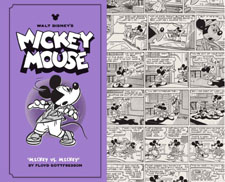 Our David Gerstein ‘book of the month’ this time around is the eleventh volume of the Fantagraphics’ Floyd Gottfredson Mickey Mouse comic strip library. Just when you thought that every last scrap of rare Gottfredson art and every last thing to be told about the man and his work is said – Gerstein and crew provide even more from an apparently bottomless well. This edition covers the strip during its deepest post-war suburban-set era, with an emphasis in story lines containing fantasy/sci-fi elements of the type in vogue during the early 1950s (1951-1953 to be exact).
Our David Gerstein ‘book of the month’ this time around is the eleventh volume of the Fantagraphics’ Floyd Gottfredson Mickey Mouse comic strip library. Just when you thought that every last scrap of rare Gottfredson art and every last thing to be told about the man and his work is said – Gerstein and crew provide even more from an apparently bottomless well. This edition covers the strip during its deepest post-war suburban-set era, with an emphasis in story lines containing fantasy/sci-fi elements of the type in vogue during the early 1950s (1951-1953 to be exact).
Among the extra goodies in the front and back matter is an informed overview by comics historian Thomas Andrea; a profile of Italian Mickey cartoonist Andrea “Casty” Castellan; a full color reprinting of his story Mickey Mouse and The 7 Dupes; A profile of Goofy and his relatives who appear in the strip; a cover gallery of Dutch, Italian and Brazilian Mickey reprint editions — and my personal favorite extra ever: Gottfredson’s rare one-shot “Astro Pooch” comic strip – used as a prop pop-art painting, ala Roy Lichtenstein – created for the live-action Disney flick, Never A Dull Moment (1969).
The comic strips themselves are a blast. Mickey and Goofy go to Hollywood to make a movie, then rent a haunted house. Mickey travels through time to the Roman era, then to the future, becomes rich by way of a magical “Midas ring”, is seduced by his human private secretary, then travels to Hawaii, is attacked by pirates, befriends a group of space aliens… on and on. All great stuff. I sincerely hope you’ve been buying these as they come out. An absolutely wonderful series that sets the bar for quality classic comic strip reprint collections.
SpongeBob Comics: Treasure Chest by Steven Hillenberg; Edited by Chris Duffy
 First off, I must confess my favorite “newsstand” commercial comic book these days is Spongebob Comics, edited by Chris Duffy and published by United Plankton Pictures (by way of Bongo Comics). It’s the only regularly published establishment comic book that really feels like a modern day version of the classic funny animal books churned out by the likes of Creston, Timely, Harvey, St. John et al. in the 40s and 50s. Duffy’s editorial POV is felt in every issue as he tries to channel that aesthetic and combine it with the wacky world of Spongebob, his supporting characters and their undersea locale.
First off, I must confess my favorite “newsstand” commercial comic book these days is Spongebob Comics, edited by Chris Duffy and published by United Plankton Pictures (by way of Bongo Comics). It’s the only regularly published establishment comic book that really feels like a modern day version of the classic funny animal books churned out by the likes of Creston, Timely, Harvey, St. John et al. in the 40s and 50s. Duffy’s editorial POV is felt in every issue as he tries to channel that aesthetic and combine it with the wacky world of Spongebob, his supporting characters and their undersea locale.
Did I mention the stories (by the likes of Sam Henderson, Graham Annable and Robert Leighton, to name but a few) are funny – and the art (by the likes of James Kolchalka, Derek Drymon, and yeah, veterans like Ramona Fradon and Al Jaffee) is superb (and funny) too. Each issue has at least one story drawn “on-model” (and even those are pretty frantic) and the rest of the issue is drawn by a variety of indy artists and industry animators who are allowed to interpret Spongebob in their own unique style – or any way they wish.
In case you missed the first 70+ issues, you are in luck. Our friends at Abrams Comic Arts are reprinting the best of the best in a series of trade paperbacks under their Amulet Books imprint. But even better – Abrams is preserving the coolest of the weird, indy-artist-driven Spongebob stories and gag pages in a new hard-cover, slip-cased book, SpongeBob Comics: Treasure Chest, which recently came out.
I can’t begin to tell you how beautiful this book is. If you want a safe way to introduce a small one in your brood to the subversive aspects of great comic art – this would be a perfect gateway drug. Tony Millionaire, Kaz, Paul Karasik (him again!), R. Sikoryak (channeling Fletcher Hanks), Stephen DeStefano, Stephen Bissette, Bob Flynn, Jerry Ordway, Dave Cooper, Sergio Aragones and on and on, the gang’s all here. Heck, buy this for yourself! Highly recommended!
Cartoon Roots: Halloween Haunts Curated by Tommy Jose Stathes
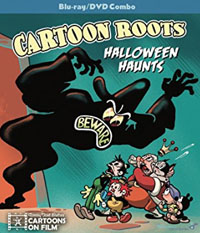 I’ll make this real easy: If you see a DVD/blu-ray collection titled “Cartoon Roots”, buy it. Simply send the money and don’t think twice.
I’ll make this real easy: If you see a DVD/blu-ray collection titled “Cartoon Roots”, buy it. Simply send the money and don’t think twice.
This is the third collection in the Cartoon Roots series from Tommy Jose Stathes’ Cartoon On Film library, and all three are important additions to your personal collection. Must-haves. Stathes is quickly becoming a force in the efforts to save historically significant animated films and doing vital, expert restoration work to preserve them. His latest Halloween-themed compilation is filled to the brim with fifteen animation rarities – from studios including Bray, Fleischer, Lantz, Disney, Kinex, Van Beuren, Pat Sullivan and others.
Needless to say these cartoons feature Koko the Clown, Felix The Cat, The original Tom & Jerry, Dinky Doodle, Mutt and Jeff, among many familiar faces. The print sources come from 16mm (and I think 35mm – the quality of such titles as Fleischer’s Ouiji Board, Sullivan’s Sure-Locked Homes, Lantz’ Just Spooks and Pete’s Haunted House are particularly outstanding). The Alice comedy here, Alice’s Mysterious Mystery is a better copy (and tinted, too) than the version on the Disney’s Treasures set.
Musical tracks by Charlie Judkins and Robert Israel add to the spooky fun. Stephen DeStefano’s cool cover (and menu image) is icing on the cake. There’s also a wonderfully informative booklet (written by several Cartoon Research regulars) and bonus features that contain rare press clippings and trade reviews of many of the cartoons in the set. Tommy even found a few cancelled checks representing what theatre owners paid to run each cartoon (Spoiler alert: $2.). Tommy’s retail price for this set allows you to enjoy these cartoons for a price lower than two bucks per cartoon – and its not a rental, you can keep this collection forever. And you’ll want to. Highly Recommended!
SHOUT OUTS and SHORT TAKES
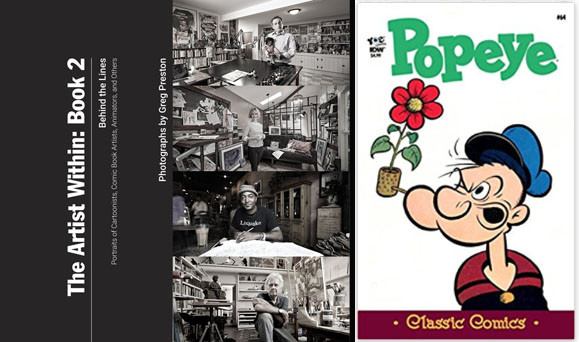
The Artist Within: Book 2 is an incredible, oversized, lavish art book filled with full page portraits of some of the greatest comic book and animation artists by professional photographer Greg Preston. This is his second book of such images – and I can’t recommend it highly enough. Over 130 spreads including such favorites – all shot in their working studios – with Chuck Jones, Ollie Johnston, Willie Ito, Jack Kirby, Drew Friedman, Glen Keane, John Musker, Chris Sanders, Floyd Norman, Genndy Tartakovsky, Dean Yeagle, R.O. Blechman, and dozens more. Scott Shaw! provides a perfect Introduction.
Classic Popeye #64 – My other favorite regularly published comic book these days is IDW’s Classic Popeye edited by Ted Adams, Clizia Gussoni and Craig Yoe. This book essentially reprints the Bud Sagendorf run on the Western Publishing (Dell/Gold Key) series of Popeye from the late 1950s and early 60s. Please note – the lead story in the latest issue (#64) features the comic book debut of “Brutus”. Sagendorf drew him here as he looks in the King Features TV-cartoons, but only for this one issue (after which he went with a more generic design). Fred Grandinetti talks more about this anomaly here. Classic Popeye #64 also boasts a variant cover by Adventure Time board artist Derek Ballard.
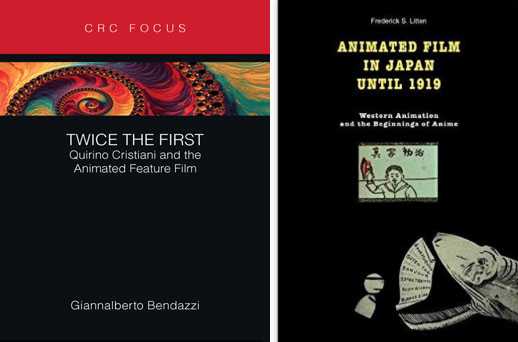
Twice the First: Quirino Cristiani and the Animated Feature Film – Animation historian Giannalberto Bendazzi (Animation: A World History) is now the editor of the Focus Animation Series, an initiative by CRC Press/Focal Press that aims to publish unique research that may not otherwise be committed to print. This first volume is an English language reprint of a 1983 Italian volume by Bendazzi on the pioneering work Argentina’s Quirino Cristiani, about his whole career as a cartoonist and filmmaker, and his lost animated feature film (yes, feature film) El Apóstol in 1917, and his first sound feature, Peludópolis from 1931. It goes beyond this to include all his work before and between these productions. Cristiani was pretty much the “Disney of Argentina” – and it even includes info (and a photo) of his meeting with Walt during the 1941 “Good Neighbor” (“el Grupo”) tour. If this interests you (as it does me) this is well worth a place on the shelf.
Animated Film in Japan Until 1919 Wow. I remember when the earliest Japanese animation that could be seen and studied were those early color features produced in the late 1950s – and anything earlier than that was scarce or buried. Today, with DVD, the internet, blogs and several lavish new books, studying the history of anime is more accessible – and more intricate than we ever imagined. Now comes the the ultimate first chapter in the story – historian Frederick Litten (a previous contributor to Cartoon Research) has published his study of the first years of the Japanese art form, one hundred years ago, in a thoroughly written (and heavily footnoted) 160-page paperback. There’s no doubt animation has shaped the world – and anime is still growing in influence. I’m grateful that Dr. Litten has documented where and how it all began, and is sharing that knowledge in this concise tome.


 Jerry Beck is a writer, animation producer, college professor and author of more than 15 books on animation history. He is a former studio exec with Nickelodeon Movies and Disney, and has written for The Hollywood Reporter and Variety. He has curated cartoons for DVD and blu-ray compilations and has lent his expertise to dozens of bonus documentaries and audio commentaries on such. Beck is currently on the faculty of Cal Arts in Valencia, UCLA in Westwood and Woodbury University in Burbank – teaching animation history. More about Jerry Beck [
Jerry Beck is a writer, animation producer, college professor and author of more than 15 books on animation history. He is a former studio exec with Nickelodeon Movies and Disney, and has written for The Hollywood Reporter and Variety. He has curated cartoons for DVD and blu-ray compilations and has lent his expertise to dozens of bonus documentaries and audio commentaries on such. Beck is currently on the faculty of Cal Arts in Valencia, UCLA in Westwood and Woodbury University in Burbank – teaching animation history. More about Jerry Beck [



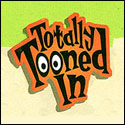



What happened to Fantagraphics’ plan to keep releasing collections of Bushmiller’s Nancy strips (in chronological order)? They stopped a few years back after only 3 books. I really enjoyed those collections…
Probably sales didn’t support further volumes. They did the same with the Walt Kelly Our Gang stories and Hank Ketchum’s Dennis the Menace.
A few years ago at a Comic Con panel on comic strip reprints publishers explained often the first volume reprinting the earliest strips generally sell best and as further volumes are released sales gradually decline. While fans want complete runs reprinted the publishers said market realities tend to make that impossible. They are first and foremost businesses.
My friend Brent Swanson has wondered more than once on Facebook whether the Carl Barks Fantagraphics series will be complete and reprint ALL The Duck Man’s word or stall when everything pre-1960 or so has been done.
Great reviews, Jerry
I have a system down to collect the box set of the two new Mickey Mouse Fantagraphic books at the end of each year. I am over the moon of having these. I really hope there is enough sales to complete the 13 intended volumes.
Our originally-planned 13 daily-strip volumes—which would have required the final books to be relatively short—became 12 volumes during development, with the final books instead being just a little longer than the norm. (It relates to how the stories are broken up… a superlong continuity in 1948 caused problems.)
The final volume is now to be Vol 12, and it should be out in December or January; Disney greenlit it awhile back and it’s now at the printers.
Next up from Fantagraphics, Disney Masters reprinting classic Disney comic book stories including the first 7 Paul Murry Muckey serials and a collection of the highly regarded Daan Jippes/Fred Milton Donald Duck collaborations. And even some Romano Scarpa and Luciano Bottaro. Coming next year
Thank you to David and anyone else who helped bring these amazing Mickey volumes out. Having these in my library has been a dream come true. The text material alone makes each volume worth having, never mind the beautiful, amazing strips.
Word of a Disney Masters book (series?) also sounds incredible. What wonderful news.
Yes, indeed, it is a series. Announced so far:
Vol. 1: Mickey Mouse—”The Delta Dimension” (Romano Scarpa)
Vol. 2: Donald Duck—”Uncle Scrooge’s Money Rocket” (Luciano Bottaro)
Vol. 3: Mickey Mouse—”The Case of the Vanishing Bandit” (Paul Murry)
Vol. 4: Donald Duck—”The Great Survival Test” (Daan Jippes and Freddy Milton)
I can already recommend Vol. 1, 2, and 4 without hesitation. Vol. 3… maybe, with some hesitation.
Just recently found out the IDW Popeye series is going to be discontinued. It was my favorite monthly comic, too. Needless to say, I’m “disgustipated”.
The Popeye Classics series was on thin ice for a long time, due to low sales. We are fortunate that IDW let it last this long. Personally, I love the big, chunky hardcover volumes. Awesome stuff.
How to read Nancy?
1) Get stoned.
2) Read Nancy.
I’ve only read “Understanding Comics” which gave me the revelation that comics are an art form and medium unto themselves. As a kid I read “Gasoline Alley” which I finally realized as in my late teens never really had a “gag” — it simply developed a sensibility or a point of view in me that made me laugh by the final panel.